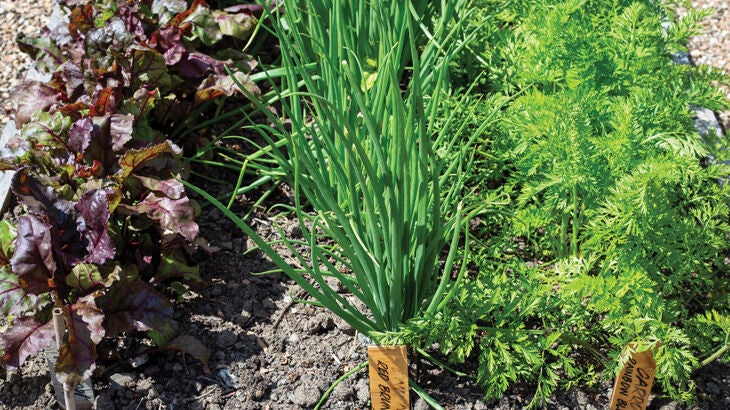Country -
Green shoots

A no-dig garden provides more than just food for thought – your wallet, mind and health will thank you.
As the cost of living bites into household budgets, lifestyle block owners have the capacity to leverage a larger property to produce some of their food needs.
Many of us lack the confidence or knowledge to start and maintain a productive garden, however, organic gardening and permaculture expert Kath Irvine says while we shouldn’t put it in the too-hard basket, it’s a good idea to take a very measured approach.
Kath recently moved on from an 8,260sqm flat rural block in Horowhenua, where she created a flourishing food garden that fed her family and her soul, to a life on the road in a 12-metre house truck with her husband Matt when their children flew the nest.
The couple are venturing around New Zealand looking for some land to potentially call home, and Kath spoke to Country from Kakanui, a small coastal settlement south of Oamaru where they’ve “hitched” their truck, and where pots of parsley, oregano, sage and mint are the only reminders of her former food garden – for now.
Kath’s popular blog, Edible Backyard, and her book of the same name, champion the permaculture route for a productive garden and she has a pragmatic and simple outlook.
“My life’s mission is to encourage the world to slow down,” she laughs.
“Growing food is not difficult if you learn how to garden in a way that works with nature, so take time, and set yourself up for success because once you start growing your own food, it’s hard to go back – it just tastes so good.”
Kath recommends allowing 12 months to get to know your land – what permaculture calls creating a base map; joining a local gardening group or online forum to get some hot tips about what does well in your area, watching the seasons, and gathering information.
“Observe where the sunny spots are, where the prevailing wind is, how the land drains after heavy rain, where the frost settles and what the soil composition is because these things will determine what will thrive.
“Good drainage is crucial for plant health, soil type will dictate your approach to planting, greenhouses will languish in the shade, and citrus trees and the veggie patch need winter sun – from 10am-2pm or a bit either side.
“Work out what you want to grow and, more importantly, what you will actually eat and if you have never gardened before, acknowledge and accept that there will be trial and error.”
Encouraging a mindset of experimentation, Kath suggests starting with some easy wins by planting containers and pots with salad greens and herbs and putting them close to the kitchen where you’ll see and use them.
“Resist the urge to spread your food garden far and wide simply because you have the space because unless you are utilising the produce and keeping on top of it, you’ll create a rod for your own back.
“You don’t need to plant seven apple trees – plant one cooking apple variety and two eating apples that ripen at different times so you don’t ultimately end up with a glut, and if you have a good spray-free blueberry farm in your neck of the woods, don’t grow them yourself – support a local business.”
The thought of double digging, compost turning and relentless weeding can put even the most enthusiastic home gardener off their veg, but Kath’s preferred “no-dig” approach will win you over.
“Contrary to what you may think, the more we dig the soil, the poorer it becomes so don’t work against nature.
“Start by laying down some paper or cardboard, put good compost on top, poke holes into that and pop your plants in.
“Learn to make compost and recycle your food scraps either with a worm farm, or using the Bokashi system. All your food scraps, garden waste, leaves, lawn clippings, and (most) weeds can – with good composting – provide all the fertility you need.
“With a good amount of dry matter and a dose of green stuff plus a bit of time, you’ll end up with beautiful, free compost and this, along with homemade mulch, is the secret to a low pest, low disease and healthy garden.”
Buying compost is expensive, and never completely devoid of persistent herbicides and pesticides which kill off the beneficial soil life and without them our plants attract pests and diseases.
“Having happy, biologically-alive compost which is essentially fermented – not decayed – matter, is the gardening equivalent of humans having a healthy gut biome for optimal well-being,” says Kath.
For optimal health, leafy greens are important and Kath suggests perusing a seed catalogue and choosing plants with a variety of textures and flavours – spicy, crunchy, creamy, bitter and sweet.
“You could be eating yummy salads and stir-fry greens at every meal, picked fresh each day with high-value health benefits.”
Kath also recommends organising your garden into zones and starting small even if you have heaps of land.
“Zone one should be close to home and be the areas you visit or pick from daily – this will include the vegetable patch, the greenhouse, and the chook house, while slightly further away, zone two will be your fruit trees.
“Embrace companion planting because food gardens can look beautiful with lots of colourful flowers and they can do the pest predation and pollination.”
Acknowledging that gardening is really therapeutic and good for mental health, Kath says for it to be sustainable and practical, work in the food garden should be little and often so it doesn’t become an arduous task and you’re not constantly starting over.
“You can catch the weeds before they get established, notice the beginnings of any pest activity, and eat crops when they are at their best.”
For more info visit: ediblebackyard.co.nz